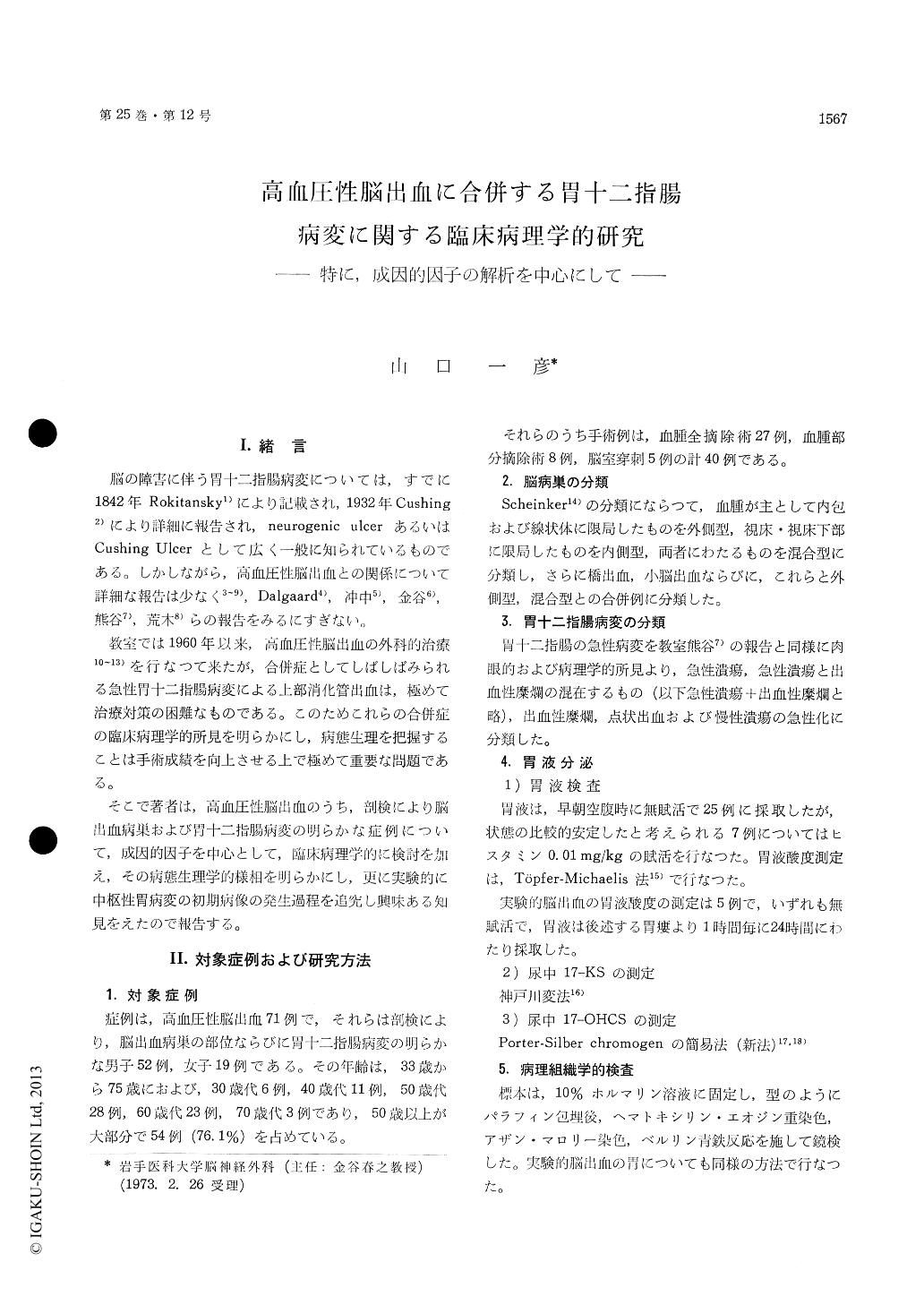Japanese
English
- 有料閲覧
- Abstract 文献概要
- 1ページ目 Look Inside
I.緒言
脳の障害に伴う胃十二指腸病変については,すでに1842年Rokitansky1)により記載され,1932年Cushing2)により詳細に報告され,neurogenic ulcerあるいはCushing Ulcerとして広く一般に知られているものである。しかしながら,高血圧性脳出血との関係について詳細な報告は少なく3〜9),Dalgaard4),沖中5),金谷6),熊谷7),荒木8)らの報告をみるにすぎない。
教室では1960年以来,高血圧性脳出血の外科的治療10〜13)を行なつて来たが,合併症としてしばしばみられる急性胃十二指腸病変による上部消化管出血は,極めて治療対策の困難なものである。このためこれらの合併症の臨床病理学的所見を明らかにし,病態生理を把握することは手術成績を向上させる上で極めて重要な問題である。
Bleeding from gastro-duodenal lesions associated with hypertensive intracerebral hemorrhage is known to be a fatal complication.
The author examined gastro-duodenal lesions in 71 autopsies on patients who had died from hyper-tensive intracerebral hemorrhage in order to know the correlation between the location of a hemor-rhage in the brain and the incidence of gasto-duodenal lesions.
As gastric acidity is known to be an etiologic factor in the formation of gastro-duodenal ulcers. the author also measured the concentration of free hydrochloric acid in 25 patients.
Furthermore, the author observed the process of the formation of gastric lesions in dogs in whichintracerebral hematoma had been produced.
In preparation for this experimental study on dogs, 20 hours prior to the production of intra-cerebral hematoma, 0. 1 mg per kilogram of reser-pine was injected subcutaneously, and a fenster of the gastric wall was made, fixing the stomach to the abdominal wall.
The intracerebral hematoma was produced by the injection of 3 ml. of autoblood into the dog's brain. Then the gastric membrane was observed for 24 hours by a romanoscope through the fenster in the abdomen of each dog.
The results obtained are as follow :
1. Gastro-duodenal lesions were found in 54 cases out of 71 autopsies (76.1%) :
9 cases…acute ulcers only・
11 cases…acute ulcers and hemorrhagic erosions
14 cases…hemorrhagic erosions only
16 cases…mucosal hemorrhages
4 cases…hemorrhage from chronic ulcers
2. As to location of the lesions, in the 54 cases, 34 had lesions in the stomach, 13 both in the stomach and in the duodenum, and seven in the duodenum only.
In most cases ulcers were multiple and they were found mainly in the area of lesser curvature. The hemorrhagic erosions were usually found in the pyloric area in the stomach.
3. Acute ulcers with or without hemorrhagic erosions as well as hemorrhagic erosions and mucosal hemorrhages were usually found in cases in which the patient had died between 6-10 days after intra-cerebral hemorrhage.
4. Half of the autopsy cases with gastro-duodenal complications had evidences of gastro-intestinal hemorrhage such as hematemesis or melena after intracerebral hemorrhage.
5. Cases in which intracerebral hematoma was found in the cerebellum or the pons had many more gastro-duodenal complications than those of the lateral type of intracerebral hemorrhage. Thecombined type of intracerebral hemorrhage also had more complications than the lateral type. However, even the lateral type, if the hematoma was present in the lymbic system, especially in the hippocampal region, showed complications in high frequency. The incidence of the gastro-duodenal complications is considered to have much closer correlation with the location of the hematoma in the brain than with the volume of hematoma.
6. Concentrations of free hydrochloric acid showed more than 40 clinical units in 11 out of 25 patients with hypertensive intracerebral hemor-rhage. No correlation between the acidity and location of the hematoma was noted.
7. In the animal experiments, all six dogs in which hematoma was produced in the brain after injection with reserpine developed mucosal hemor-rhage in the gastric membrane. Three dogs showed mucosal hemorrhage one hour after production of intracerebral hematoma. The fourth, fifth and sixth dogs developed lesions after 3, 5 and 8 hours respectively. Four out of the six dogs developed not only mucosal hemorrhages but also erosions of the gastric membrane.
The erosions thus produced experimentally can be divided into three types according to the pro-cess of formation :
Type I…Initially two or three spots of mucosal hemorrhage appeared at nearly the same time and they fused with each other after developing. Finally they formed an erosion.
Type II…Many spots of mucosal hemorrhage appear-peared at nearly the same time and they de- veloped into an erosion after fusing with each other.
Type III…One spot of mucosal hemorrhage appear- ed and developed into an erosion.
As to the time of appearance of mucosal hemor-rhages, four out of five dogs developed the lesions when the gastric acidity was decreasing.

Copyright © 1973, Igaku-Shoin Ltd. All rights reserved.


